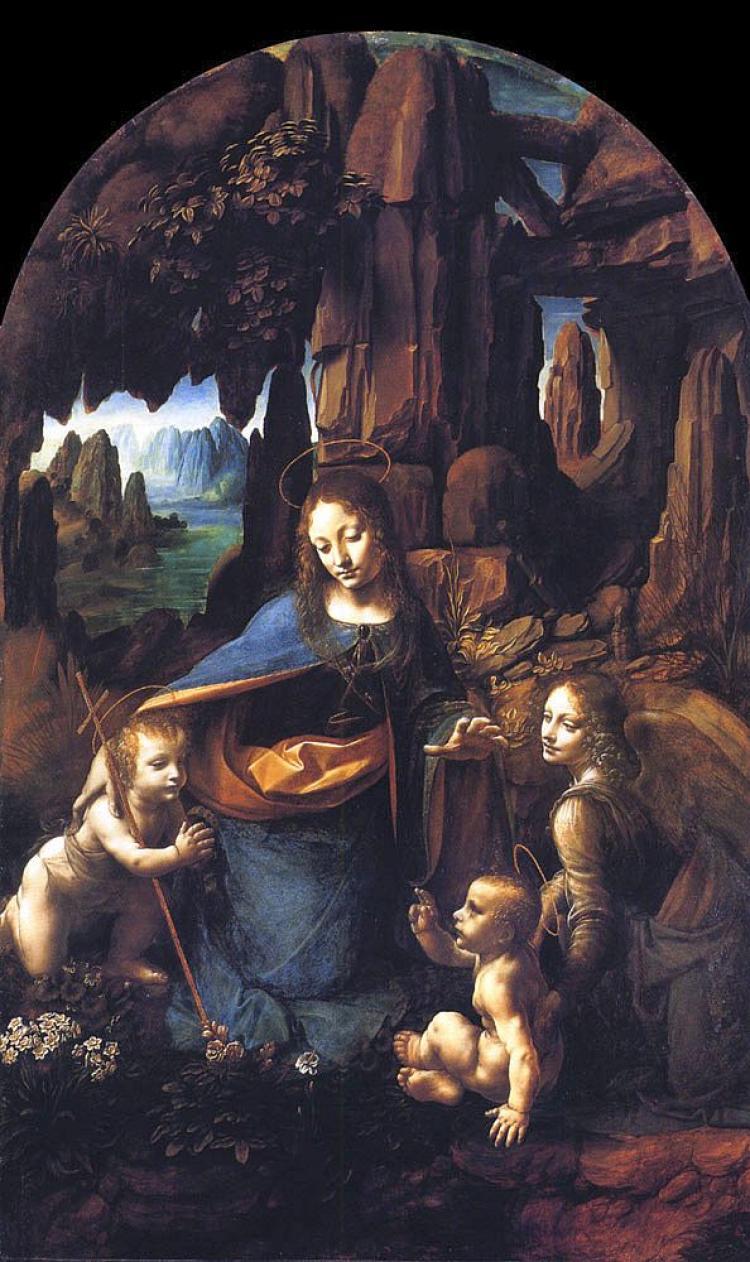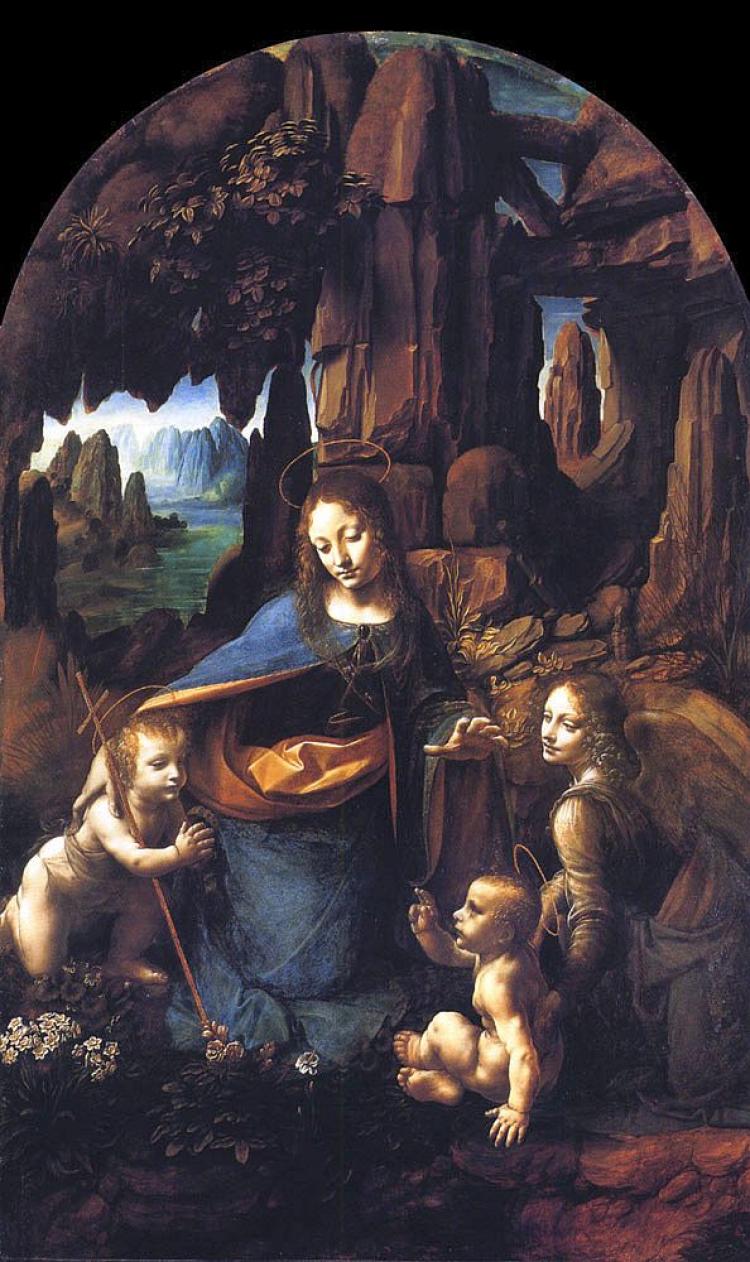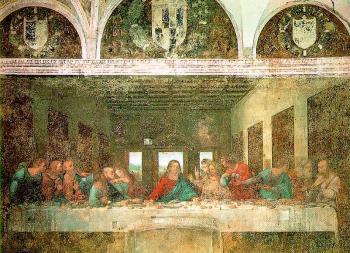Leonardo da Vinci’s “Virgin of the Rocks” is a perfect example of da Vinci’s superior shading and subtle transitions from light to dark—creation of an illusionistic atmosphere.
This timeless masterpiece depicts the infant Christ, the Virgin Mary, and another small figure with an angel nearby—figures common in 15th century Italian altarpieces.
Columbia art professor David Rosand, former chairman of Department of Art History and Archeology, explains the angel’s stance: “A figure who looks out at us, who establishes contact with the viewer, invites us into the painting. The angel points across the painting to another figure, to another slightly larger infant.”
The “slightly larger infant” would be St. John the Baptist, there simply because Leonardo decided to put him there.
“This is a Leonardo invention … the young John, of course. When he is older, he will be out in the desert for 40 years, and he will come back to preach the coming of Christ. He will be the first to baptize Christ thereby establishing baptism as one of the sacraments of the Church.”
According to Rosand, the grouping is significant. “What is so interesting with Leonardo is that once again, he takes these disparate figures and brings them into a single group. He unifies them; he gives them great unity. This is an aspect of this great artwork that Vasari in the middle of the 16th century recognized—to take the disparate unit of various figures and to give them a single unitary form.”
While the angel points at John, Mary reaches out to both John and Jesus. Jesus gives his cousin the sign of benediction, the way the Pope would bless a crowd or how saints would gesture on behalf of Christ, completing the circle of relationships.
The rocky landscape is also a page from Leonardo’s imagination. From the backdrop, it is clear that “he recognizes the earth itself is not merely something that was finished on the sixth day of creation and then God rested. But that the earth itself carries all of the traces of being in constant motion and in this, of course, he is picking up on—repeating—certain kinds of ancient natural philosophy. But basically his observations, as he always insists, are based upon his own experience.”
Being not only an artist but also a geologist, a mathematician, and a skilled anatomist, Leonardo spent time and effort carefully studying rocks and the water that wore them away year after year.
“He looked at those rocks carefully. He found fossils up in the mountains, and he said there must have been a flood. … He also recognizes that the earth is filled with violence and activity, and the greatest violence comes from water. He talks about the power of water and how it basically over time does away with the rocks,” said Rosand.
Rosand says these observations then find their way into Leonardo’s art. “He is very impressed by this and … that takes us back to his attitude toward the art of the painter—to the sketch. Don’t set it down because you will want to change it. It is always there to be changed. In effect, this is what happens here in the sense that his knowledge of rocks, these rocks, have been carved by the ravages of time, mostly from water.”
The Virgin Mary has been compared to rocks and mountains and such, and “through that comparison, she is declared to be essentially greater than they are but also older than they are. In the liturgy—once again, one must go back to the religion in the liturgy—Mary is declared to be present from the very beginning.”
Time and eternity play an important role here. As an artist, Leonardo implies a deeper meaning. “It is important because for Leonardo, these rocks simply represent in one way or another the record of the passage of time. And in this they represent the mortality of the earth. And to set the Virgin against this is, of course, to suggest a clear contrast. This is how a painter, likely or not, would think, asking the question, are they symbolic?”
Rosand contends that it is artists, not theologians or scientists, who answer some of life’s important questions. “Once you ask the question, the answers are there. But no theologian would have the imagination to say, ‘Look, why did you put rocks there because she is older than the rocks,’ and so forth.
“This is where painters become extremely—not just knowledgeable—but they are the ones who imagine the possibilities of giving a pictorial form to this particular culture, this particular religious culture. It is one of the great achievements of Leonardo.”
Columbia University professor Rosand has served twice as chairman of the Department of Art History and Archeology, as director of Art Humanities, and as chairman of the Society of Fellows in the Humanities. He currently chairs the department’s Wallach Art Gallery Committee.
The second annual Chinese International Figure Painting Competition will exhibit winners’ works between Nov. 29 and Dec. 10, 2009, at the Salmagundi Art Club, New York. For more information, please visit Oilpainting.ntdtv.com/en.
Additional reporting by NTDTV, a media partner of The Epoch Times.
This timeless masterpiece depicts the infant Christ, the Virgin Mary, and another small figure with an angel nearby—figures common in 15th century Italian altarpieces.
Columbia art professor David Rosand, former chairman of Department of Art History and Archeology, explains the angel’s stance: “A figure who looks out at us, who establishes contact with the viewer, invites us into the painting. The angel points across the painting to another figure, to another slightly larger infant.”
The “slightly larger infant” would be St. John the Baptist, there simply because Leonardo decided to put him there.
“This is a Leonardo invention … the young John, of course. When he is older, he will be out in the desert for 40 years, and he will come back to preach the coming of Christ. He will be the first to baptize Christ thereby establishing baptism as one of the sacraments of the Church.”
According to Rosand, the grouping is significant. “What is so interesting with Leonardo is that once again, he takes these disparate figures and brings them into a single group. He unifies them; he gives them great unity. This is an aspect of this great artwork that Vasari in the middle of the 16th century recognized—to take the disparate unit of various figures and to give them a single unitary form.”
While the angel points at John, Mary reaches out to both John and Jesus. Jesus gives his cousin the sign of benediction, the way the Pope would bless a crowd or how saints would gesture on behalf of Christ, completing the circle of relationships.
The rocky landscape is also a page from Leonardo’s imagination. From the backdrop, it is clear that “he recognizes the earth itself is not merely something that was finished on the sixth day of creation and then God rested. But that the earth itself carries all of the traces of being in constant motion and in this, of course, he is picking up on—repeating—certain kinds of ancient natural philosophy. But basically his observations, as he always insists, are based upon his own experience.”
Being not only an artist but also a geologist, a mathematician, and a skilled anatomist, Leonardo spent time and effort carefully studying rocks and the water that wore them away year after year.
“He looked at those rocks carefully. He found fossils up in the mountains, and he said there must have been a flood. … He also recognizes that the earth is filled with violence and activity, and the greatest violence comes from water. He talks about the power of water and how it basically over time does away with the rocks,” said Rosand.
Rosand says these observations then find their way into Leonardo’s art. “He is very impressed by this and … that takes us back to his attitude toward the art of the painter—to the sketch. Don’t set it down because you will want to change it. It is always there to be changed. In effect, this is what happens here in the sense that his knowledge of rocks, these rocks, have been carved by the ravages of time, mostly from water.”
The Virgin Mary has been compared to rocks and mountains and such, and “through that comparison, she is declared to be essentially greater than they are but also older than they are. In the liturgy—once again, one must go back to the religion in the liturgy—Mary is declared to be present from the very beginning.”
Time and eternity play an important role here. As an artist, Leonardo implies a deeper meaning. “It is important because for Leonardo, these rocks simply represent in one way or another the record of the passage of time. And in this they represent the mortality of the earth. And to set the Virgin against this is, of course, to suggest a clear contrast. This is how a painter, likely or not, would think, asking the question, are they symbolic?”
Rosand contends that it is artists, not theologians or scientists, who answer some of life’s important questions. “Once you ask the question, the answers are there. But no theologian would have the imagination to say, ‘Look, why did you put rocks there because she is older than the rocks,’ and so forth.
“This is where painters become extremely—not just knowledgeable—but they are the ones who imagine the possibilities of giving a pictorial form to this particular culture, this particular religious culture. It is one of the great achievements of Leonardo.”
Columbia University professor Rosand has served twice as chairman of the Department of Art History and Archeology, as director of Art Humanities, and as chairman of the Society of Fellows in the Humanities. He currently chairs the department’s Wallach Art Gallery Committee.
The second annual Chinese International Figure Painting Competition will exhibit winners’ works between Nov. 29 and Dec. 10, 2009, at the Salmagundi Art Club, New York. For more information, please visit Oilpainting.ntdtv.com/en.
Additional reporting by NTDTV, a media partner of The Epoch Times.




